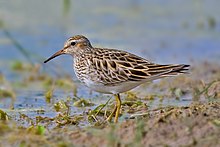Pectoral sandpiper
| Pectoral sandpiper | |
|---|---|
 |
|
| Adult in breeding plumage | |
 |
|
| Adult non-breeding | |
| Scientific classification | |
| Kingdom: | Animalia |
| Phylum: | Chordata |
| Class: | Aves |
| Subclass: | Neornithes |
| Infraclass: | Neognathae |
| Superorder: | Neoaves |
| Order: | Charadriiformes |
| Suborder: | Scolopaci |
| Family: | Scolopacidae |
| Genus: | Calidris (disputed) |
| Species: | C. melanotos |
| Binomial name | |
|
Calidris melanotos Vieillot, 1819 |
|
| Synonyms | |
|
Actodromas maculata |
|
Actodromas maculata
Erolia melanotos
The pectoral sandpiper (Calidris melanotos) is a small, migratory wader that breeds in North America and Asia, wintering in South America and Oceania. It eats small invertebrates. Its nest, a hole scraped in the ground and with a thick lining, is deep enough to protect its four eggs from the cool breezes of its breeding grounds. The pectoral sandpiper is 21 cm (8.3 in) long, with a wingspan of 46 cm (18 in).
The pectoral sandpiper is sometimes separated with the "stint" sandpipers in Erolia. This may or may not represent a good monophyletic group, depending on the placement of the phylogenetically enigmatic curlew sandpiper ("C." ferruginea), the type species of Erolia. In any case, the genus name Ereunetes—formerly used for the western sandpiper ("C." mauri) and semipalmated sandpiper ("C." pusilla), which are also members of the stint clade—was established before Erolia.
"Cox's sandpiper" ("Calidris" × paramelanotos) is a stereotyped hybrid between this species and the curlew sandpiper. This does not prove a particularly close relationship between these two species, as far more distantly related waders have successfully hybridized. In any case, among the stint clade the red-necked stint ("C." ruficollis) and the long-toed stint ("C." subminuta) are particularly close relatives of the pectoral sandpiper.
...
Wikipedia

